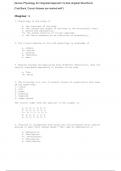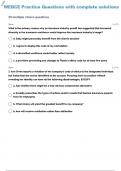(Human Physiology An Integrated Approach 7e Dee Unglaub Silverthorn)
(Test Bank, Correct Answer are marked with*)
Chapter 1
1. Physiology is the study of
a. the structure of the body.
b. the tissues and organs of the body at the microscopic level.
c. growth and reproduction.
*d. the normal function of living organisms.
e. the facial features as an indication of personality.
2. The literal meaning of the term physiology is knowledge of
a. organs.
*b. nature.
c. science.
d. chemistry.
e. math.
3. Because anatomy and physiology have different definitions, they are
usually considered separately in studies of the body.
a. True
*b. False
4. The following is a list of several levels of organization that make
up the human body.
1. tissue
2. cell
3. organ
4. molecule
5. organism
6. organ system
The correct order from the smallest to the largest is
a. 2, 4, 1, 3, 6, 5.
b. 4, 2, 1, 6, 3, 5.
*c. 4, 2, 1, 3, 6, 5.
d. 4, 2, 3, 1, 6, 5.
e. 6, 4, 5, 2, 3, 1.
5. "Glucose is transported from blood into cells because cells require
glucose to meet their energy needs." This type of explanation is
a. mechanistic.
b. theological.
*c. teleological.
d. metalogical.
e. scatological.
,6. "Glucose is transported from blood into cells by transporters in
response to insulin." This type of explanation is
*a. mechanistic.
b. theological.
c. teleological.
d. metalogical.
e. scatological.
7. Which of the following is a buffer zone between the outside world
and most of the cells of the body?
a. cell membrane
b. red blood cells
c. intracellular fluid
*d. extracellular fluid
e. All of the answers are correct.
8. Which of the following is one of Cannon's "internal secretions"?
*a. hormones
b. nutrients
c. water
d. inorganic ions
e. None of the answers are correct.
9. The study of body function in a disease state is
a. necrology.
b. physiology.
c. microbiology.
*d. pathophysiology.
e. histology.
10. Homeostasis is the ability of the body to
a. prevent the external environment from changing.
b. prevent the internal environment from changing.
*c. quickly restore changed conditions to normal.
d. ignore external stimuli to remain in a state of rest.
e. prevent excessive blood loss.
11. Oxytocin is a hormone that is released in response to cervical
dilation. It in turn causes more uterine contractions that will further
dilate the cervix. Which type of feedback loop does oxytocin trigger?
a. negative feedback
*b. positive feedback
, c. local control
d. nociceptive feedback
12. How genetics influences the body's response to drugs is called
a. pharmacokinetics.
b. pharmacogenetics.
*c. pharmacogenomics.
d. pharmacodynamics.
e. pharmageddon.
13. A physician basing clinical decisions on primary research published
in biomedical literature is doing ________ medicine.
*a. evidence-based
b. traditional
c. alternative
d. whimsical
e. holistic
14. A study in which a participant acts as an experimental subject in
part of the experiment and a control in another part of the experiment
is called a ________ study.
a. double-blind
*b. crossover
c. meta-analysis
d. retrospective
15. The Internet database for molecular, cellular, and physiological
information is called the ________ Project.
a. Human Genome
b. Physiognomy
c. Physiosome
*d. Physiome
e. Manhattan
16. A placebo is
a. any drug being tested in a clinical trial.
b. any drug in a class of drugs commonly used as pain relievers.
*c. a drug or treatment that is expected to have no
pharmacological effect.
d. a nutritive and respiratory organ in fetal development.
e. a hole in a cavity wall through which an organ protrudes.
, 17. A technique used to resolve contradictory results in scientific
studies is
*a. meta-analysis.
b. retrospective analysis.
c. prospective analysis.
d. cross-sectional analysis.
e. longitudinal analysis.
18. A scientifically logical guess is a
a. model.
b. theory.
*c. hypothesis.
d. law.
e. variable.
19. If a scientific model is supported or verified repeatedly by
multiple investigators, it may become a
a. model.
*b. theory.
c. hypothesis.
d. law.
e. variable.
20. Place these terms in the typical sequence in which they appear in
the process of scientific inquiry: experimental data, theory, model,
observation, hypothesis, replication.
a. experimental data, theory, model, observation, hypothesis,
replication
b. replication, hypothesis, experimental data, theory, model,
observation
c. theory, observation, experimental data, hypothesis,
replication, model
d. observation, replication, model, experimental data,
hypothesis, theory
*e. observation, hypothesis, experimental data, replication,
model, theory
21. You are interested in learning more about Parkinson's disease, a
neurological disorder that primarily affects motor function. Which is
the best source to begin your investigation?
a. Ask.com
*b. MedlinePlusPubMed
c. public library
d. physiology textbook
e. a physician





